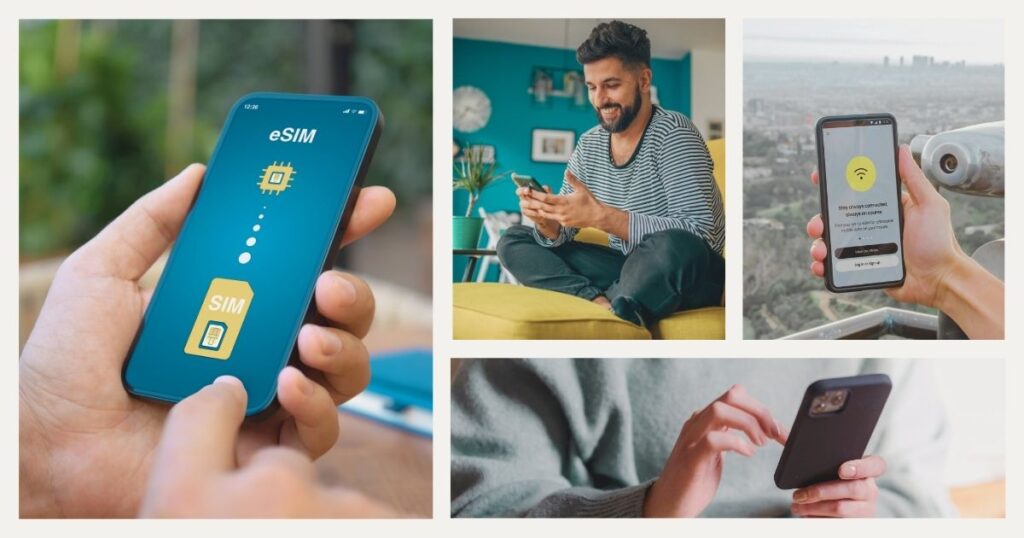Digital nomads rely on seamless connectivity to maintain their location-independent lifestyle, and eSIM technology has emerged as a game-changer for global travelers. However, as with any digital innovation, security concerns naturally arise. The question “can eSIM be hacked?” has become increasingly relevant as more remote professionals adopt this technology for their international communication needs.
Understanding the security implications of eSIM technology isn’t just about protecting your phone calls or text messages—it’s about safeguarding your entire digital workflow. For digital nomads, a compromised eSIM could potentially disrupt client meetings, compromise sensitive work data, or even lead to identity theft while far from home.
In this comprehensive guide, Nomada explores the realistic security considerations surrounding eSIM technology, addressing the common concern of “can eSIM be hacked?” and separating fact from fiction to help you make informed decisions about your connectivity solutions as you work from anywhere in the world.
Understanding eSIM technology and its security architecture

Before addressing whether an eSIM can be hacked, it’s essential to understand how this technology fundamentally differs from traditional physical SIM cards and the security framework built into its design.
What makes eSIM different from physical SIM cards
An eSIM (embedded Subscriber Identity Module) is a digital SIM that allows you to activate a cellular plan without using a physical SIM card. Unlike traditional cards that can be physically removed from your device, an eSIM is a small chip soldered directly to your phone’s motherboard. This integration creates the first layer of security when considering if an eSIM can be hacked—physical access to the eSIM is virtually impossible without damaging the device itself.
The technology uses a globally standardized architecture developed by the GSMA (the organization representing mobile network operators worldwide). This standardization ensures consistent security protocols across different device manufacturers and mobile carriers. When you activate an eSIM profile, the data is downloaded securely through an encrypted channel and stored in a dedicated secure element within your device, separated from the rest of your phone’s operating system.
🌟 Pro tip: when selecting devices for your digital nomad toolkit, prioritize those with eSIM capabilities from major manufacturers who regularly issue security updates. Devices like newer iPhones, Google Pixel phones, and Samsung Galaxy models typically receive security patches more frequently, enhancing your eSIM’s protection against newly discovered vulnerabilities.
The encryption and authentication safeguards
eSIM security is built on multiple layers of encryption and authentication. When an eSIM profile is provisioned, it uses sophisticated cryptographic algorithms similar to those employed in banking applications. This encryption secures both the data transmission during setup and the stored profile information afterward.
Each eSIM contains a unique identifier and private key cryptographically signed by the manufacturer, making unauthorized duplication extremely difficult. Additionally, the communication between your eSIM and mobile networks employs mutual authentication—your eSIM verifies the network’s identity while the network simultaneously confirms your eSIM’s legitimacy. This two-way verification helps prevent man-in-the-middle attacks where hackers attempt to intercept communications by posing as legitimate networks.
💡 Did you know? eSIMs actually offer enhanced security over physical SIM cards in several ways. While traditional SIM cards can be stolen, swapped, or cloned relatively easily with physical access, eSIMs eliminate these vulnerabilities by being permanently embedded in your device and requiring digital authentication for any profile changes.
Real security vulnerabilities vs. theoretical concerns

When evaluating if an eSIM can be hacked, digital nomads should distinguish between theoretical security models and practical, documented vulnerabilities that might actually impact their connectivity.
Documented eSIM security incidents and attacks
Despite growing adoption, confirmed security breaches specifically targeting eSIM technology remain remarkably rare. Most documented incidents have involved adjacent systems rather than the eSIM architecture itself. For example:
- Social engineering attacks: rather than hacking the eSIM directly, attackers have occasionally targeted mobile carrier employees through elaborate deception to gain unauthorized access to customer accounts and initiate SIM swapping.
- Remote provisioning server vulnerabilities: in limited cases, security researchers have identified potential weaknesses in the servers that deliver eSIM profiles, though most major providers have promptly addressed these issues.
What’s notably absent from security literature are widespread, successful attacks against the core eSIM architecture itself. The question “can eSIM be hacked?” has been extensively examined by cybersecurity researchers, and the technology’s design principles, which include isolated secure elements and cryptographic verification, have thus far proven resilient against direct compromise.
Threat modeling for digital nomads
For digital nomads evaluating “can eSIM be hacked?” in relation to their specific circumstances, context matters significantly. Your threat profile depends largely on:
- Types of data you handle: those working with high-value intellectual property or financial information may warrant additional security precautions beyond what the average remote worker requires.
- Destinations: some countries have more sophisticated surveillance infrastructure or higher rates of digital crime, potentially increasing your risk exposure.
The most realistic threats for most digital nomads aren’t direct attacks against eSIM cryptography but rather security compromises at the account level. When analyzing if an eSIM can be hacked, it’s important to note that if someone gains access to your mobile carrier account credentials or successfully impersonates you during customer service interactions, they could potentially manipulate your eSIM profiles without ever “hacking” the eSIM itself.
🌟 Pro tip: create a separate, secure email address exclusively for your eSIM and mobile carrier accounts. Use this email only for account management, secure it with a strong unique password and two-factor authentication, and don’t share it for other services. This significantly reduces the risk of unauthorized eSIM profile management if your primary email accounts are compromised.
Practical security measures for eSIM-using digital nomads

Understanding the theoretical aspects of eSIM security is important, but implementing practical protection measures is essential for digital nomads who depend on reliable, secure connectivity as they travel.
Securing your device and eSIM profiles
Your device’s overall security directly impacts your eSIM security. Follow these essential practices to minimize the risk when considering if an eSIM can be hacked:
- Keep your device updated: install operating system updates promptly, as they often contain critical security patches for eSIM-related components.
- Use strong authentication: protect your device with strong biometric authentication (fingerprint or facial recognition) and a complex passcode.
- Enable remote wipe capabilities: configure features like Find My iPhone (iOS) or Find My Device (Android) to remotely erase your data, including eSIM profiles, if your device is lost or stolen.
- Manage eSIM QR codes securely: if you receive QR codes for eSIM activation, delete them after use and never share them, as they can potentially be used to clone your mobile identity.
Many digital nomads use a reliable travel eSIM from Holafly that offers secure provisioning through their dedicated application rather than potentially less secure email or messaging channels. This approach reduces the exposure of sensitive activation information that could potentially be intercepted during transmission.
Carrier account security best practices
Your mobile carrier account security is often the weakest link in eSIM protection and the most likely point of attack when considering if an eSIM can be hacked:
- Use unique, strong passwords: create a complex, unique password for your carrier account portal.
- Enable multi-factor authentication: whenever available, activate additional verification steps for account changes.
- Set account security questions wisely: use answers that aren’t publicly available through your social media or professional profiles.
- Add port-out protection: request additional security measures that prevent unauthorized transfer of your number to another carrier.
Key considerations for maximizing your eSIM security while traveling:
- Be wary of public charging stations that could potentially compromise your device
- Avoid connecting to unsecured public Wi-Fi when managing eSIM profiles
- Consider using a privacy screen when entering carrier credentials in public places
- Maintain backup connectivity options in case your primary eSIM encounters issues
🌟 Pro tip: create a digital travel security checklist that includes not just eSIM security but comprehensive protection for all your digital assets. Review and implement this checklist before each journey to ensure consistent security practices regardless of your destination.
Final thoughts on eSIM security for location-independent professionals
When addressing the question “can eSIM be hacked?”, the answer requires nuance. While the core technology offers robust security by design, the broader ecosystem surrounding eSIM usage presents potential vulnerabilities that digital nomads should proactively address.
The good news is that eSIM technology actually represents a security improvement over traditional physical SIM cards in many respects. The elimination of physical SIM swapping, the implementation of sophisticated encryption, and the integration with device security features collectively create a considerably more secure environment for your mobile connectivity.
For most digital nomads, implementing the straightforward security practices outlined in this guide will provide substantial protection against the most likely threats when considering if an eSIM can be hacked. As eSIM adoption continues to accelerate globally, maintaining awareness of emerging security considerations will remain important, but the technology’s fundamental security architecture offers a solid foundation for confident use.
For more insights on maintaining digital security while embracing a location-independent lifestyle, explore our comprehensive guide to cybersecurity for digital nomads featuring additional strategies for protecting your digital workspace across borders.
Stay connected and protected wherever your digital nomad journey takes you 👉
Stay connected while you travel with Holafly’s eSIM 🌍
Getting ready for a trip and want to forget about roaming charges, physical SIM cards, or unreliable public WiFi? With Holafly’s eSIM, staying online in over 160 countries is easier than ever.
With Holafly, you’ll enjoy:
📲 Instant activation: just scan a QR code and you’ll have data at your destination.
🌐 Global coverage: available in 160+ countries, including top tourist spots and major business hubs.
📅 Flexible plans: choose daily, weekly, or monthly options based on your travel needs.
❌ No physical SIM required: keep your current SIM in place, no local procedures needed.
💬 Multilingual support: get fast, clear assistance whenever you need it.
Browse securely without relying on public networks, access maps, apps, bookings, and work remotely without interruptions.
Set it up once and easily pause or switch profiles as needed, saving battery and managing your data usage.
📵 Say goodbye to roaming fees and hello to a simple, secure connection—without surprises on your bill.
Does your phone support eSIM? Then Holafly is the perfect travel companion to stay connected wherever you go.
Frequently asked questions about eSIM security
Yes, eSIM technology offers several security advantages over traditional physical SIM cards. Since the eSIM is embedded directly into your device’s hardware, it cannot be physically removed, stolen, or swapped without your knowledge. The question “can eSIM be hacked?” is less concerning than the vulnerabilities of physical SIM cards, which can be more easily cloned with physical access.
Direct remote hacking of properly implemented eSIM technology is extremely difficult due to multiple layers of encryption and authentication. The more realistic remote threat comes from attackers gaining access to your mobile carrier account through phishing or social engineering, which would allow them to potentially manage your eSIM profiles without technically “hacking” the eSIM itself.
No, eSIMs don’t inherently increase location tracking vulnerability compared to physical SIM cards. Both technologies enable similar location tracking capabilities by mobile carriers as required by telecommunications regulations. For enhanced privacy, digital nomads concerned about location tracking should explore additional measures like using a VPN and adjusting their device’s location services settings.
If you notice unusual activity like unexpected service interruptions, unrecognized outgoing messages, or authentication notifications you didn’t initiate, contact your mobile carrier immediately to lock your account and verify your active eSIM profiles. Change your carrier account password, review recent account activities, and scan your device for malware. For digital nomads, it’s wise to have a backup connectivity option ready to activate in such scenarios.




